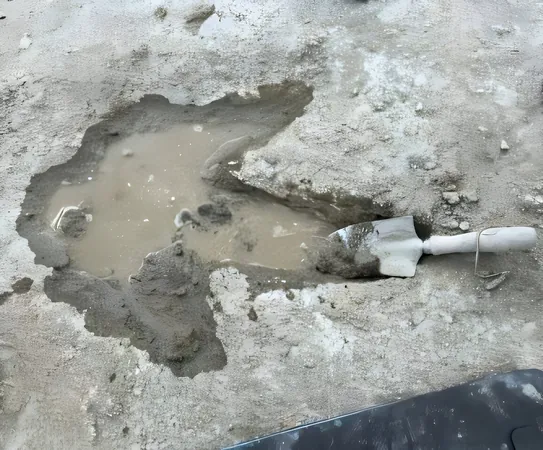
New Dinosaur Highway Discovered: Hundreds of Ancient Footprints Unearthed in Oxfordshire!
2025-01-06
Author: Amelia
New Dinosaur Highway Discovered: Hundreds of Ancient Footprints Unearthed in Oxfordshire!
In a breathtaking discovery that could reshape our understanding of dinosaur behavior, a dedicated team from the Universities of Oxford and Birmingham has unveiled a sprawling quarry floor brimming with hundreds of diverse dinosaur footprints in Oxfordshire, England. These remarkable revelations could very well redefine what paleontologists know about the interactions of these prehistoric creatures.
The footprints, believed to date back to the Middle Jurassic Period, approximately 166 million years ago, are part of what scientists are dubbing a "dinosaur highway." Among the extraordinary finds are tracks from the nine-meter-long predator, Megalosaurus, and massive herbivorous dinosaurs that could reach lengths of up to 18 meters, particularly from the colossal long-necked sauropods, likely representatives of the Cetiosaurus species.
An Expansive Discovery
During the excavation, researchers identified five primary trackways, revealing a wealth of information about the creatures that once inhabited this region. One of the longest trackways measures over 150 meters and includes clear evidence of interactions between herbivorous sauropods and the formidable Megalosaurus, suggesting these dinosaurs might have coexisted and possibly interacted within a shared environment.
Emma Nicholls, a vertebrate paleontologist at the Oxford University Museum of Natural History, remarked, “Scientists have studied the Megalosaurus for longer than any other dinosaur, yet these recent discoveries highlight that we are still unearthing evidence of their past.”
A Chance Encounter Sparks Discovery
The quest for these ancient artifacts began when quarry worker Gary Johnson noticed peculiar, “unusual bumps” in the clay while preparing the site. His keen observation prompted further investigation, ultimately leading to an extensive excavation that unfolded over a week in June 2024. With the assistance of Quarry Manager Mark Stanway, the research team meticulously uncovered around 200 pristine footprints.
Utilizing cutting-edge aerial drone photography, researchers were able to create detailed 3D models of the trackways, ensuring these findings are preserved for future scholarly research.
Linking Past and Present
Interestingly, this recent discovery connects to significant findings made in the same area back in 1997 when over 40 sets of footprints were revealed, stretching an impressive 180 meters. However, the lack of advanced technology at that time limited documentation efforts. Today, modern techniques allow for far more comprehensive recording, enabling scientists to gain deeper insights into dinosaur biology and behavior.
Kirsty Edgar, a micropaleontologist at the University of Birmingham, emphasized the importance of these footprints, stating, “They provide an extraordinary look into the lives of dinosaurs, showcasing their movements and interactions in a long-lost tropical setting.”
Insights into Ancient Environments
The preserved footprints not only offer a glimpse into the dinosaurs' travels but also into the geological backdrop of their time. This site was once a muddy lagoon, rich in biodiversity where these majestic creatures roamed. Earth scientist Duncan Murdock noted, “The preservation is so exquisite that we can see how the mud deformed as the dinosaurs walked, creating a vivid picture of their world.”
Upcoming Features and Exhibitions
This remarkable find will be highlighted in an upcoming episode of BBC’s *Digging for Britain*, hosted by Professor Alice Roberts, airing on January 8, 2025. Viewers will witness how these ancient tracks contribute to a greater understanding of dinosaur evolution.
Additionally, the Oxford University Museum of Natural History plans to incorporate these findings into their “Breaking Ground” exhibition, showcasing key moments in our planet's and life’s history. Visitors will not only see original fossils of the Megalosaurus but also learn about the innovative paleontological methods used in modern research.
As this dinosaur highway continues to be studied, it demonstrates the incredible power of modern technology to illuminate the mysteries of the distant past. Who knows what other secrets lie beneath our feet, waiting to be uncovered?



 Brasil (PT)
Brasil (PT)
 Canada (EN)
Canada (EN)
 Chile (ES)
Chile (ES)
 Česko (CS)
Česko (CS)
 대한민국 (KO)
대한민국 (KO)
 España (ES)
España (ES)
 France (FR)
France (FR)
 Hong Kong (EN)
Hong Kong (EN)
 Italia (IT)
Italia (IT)
 日本 (JA)
日本 (JA)
 Magyarország (HU)
Magyarország (HU)
 Norge (NO)
Norge (NO)
 Polska (PL)
Polska (PL)
 Schweiz (DE)
Schweiz (DE)
 Singapore (EN)
Singapore (EN)
 Sverige (SV)
Sverige (SV)
 Suomi (FI)
Suomi (FI)
 Türkiye (TR)
Türkiye (TR)
 الإمارات العربية المتحدة (AR)
الإمارات العربية المتحدة (AR)